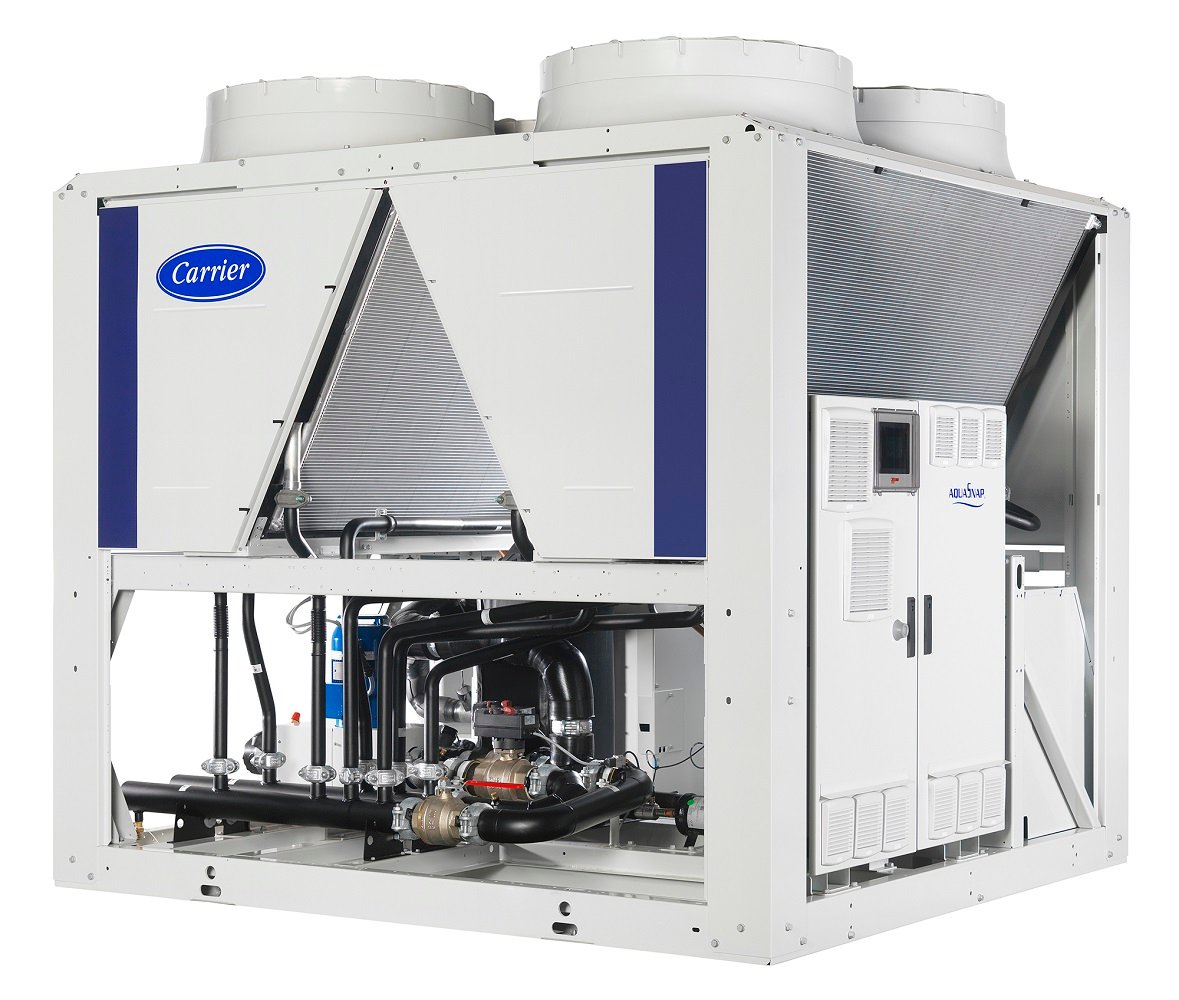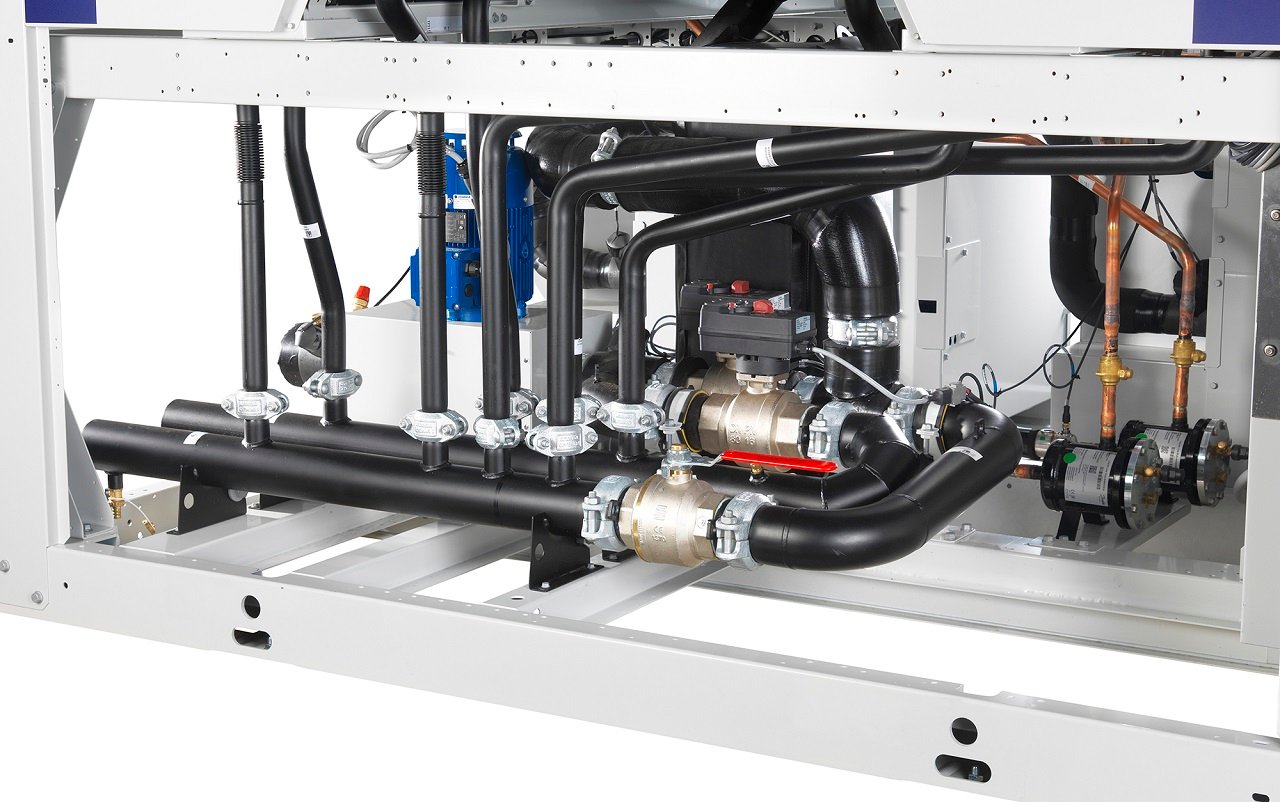Carrier has introduced high-performance heat recovery and free cooling options to its AquaSnap 30RBP air-cooled scroll chiller range on lower global warming potential (GWP) R-32 refrigerant, providing even greater energy savings and further reducing operating costs for end users.
Carrier was the first European manufacturer to introduce a fully optimised scroll chiller range on R-32. AquaSnap units also have an outstanding seasonal energy performance ratio (SEER) for cooling of up to 6.62, reducing indirect greenhouse gas emissions resulting from energy use. The latest heat recovery and free cooling options extend energy savings, further reducing greenhouse gas emissions over the lifetime of the equipment.
The heat recovery system enables chillers to produce domestic hot water up to 80deg C, while continuing to provide cooling, useful for applications such as hotels, hospitals and industrial processes requiring hot water. The free cooling option makes use of favourable ambient and load conditions, harnessing free cooling from the environment to augment or replace mechanical cooling via the chiller's compressors, reducing energy consumption and running costs.
Two versions of free cooling are available. Partial free cooling is designed for applications with a variable primary cooling load, such as offices and healthcare, which may also have a constant residual cooling need. Examples include computer suites or scanner facilities. The total free cooling option is designed for applications with a constant cooling need throughout the year, such as industrial processes and data centres.
Carrier's hydronic-based free-cooling system automatically activates when the outdoor air temperature drops 1 degree C below the chiller's return water temperature, harnessing the full free cooling opportunity and maximising energy savings. For example in Berlin, the hydronic free cooling potential is 50 to 95% of annual chiller run-time, depending on the application. In more northern locations, the potential free cooling opportunity is even greater.
If free cooling is not sufficient to meet requirements, a mixed mode – using both free cooling and mechanical cooling – is automatically activated, ensuring the cooling needs of mission critical applications are always met.
14 June 2022
Carrier Adds Heat Recovery and Free Cooling Options Extending R-32 Scroll Chiller Energy Savings
Related news
Johnson Controls Expands YORK YVAM Chiller Availability to Europe A...
Johnson Controls has introduced its YORK YVAM air-cooled magnetic bearing chiller to the European market, aiming to support the region’s growing data centre industry. As artificial intelligence...
19 Mar 2025
Smardt launches ECO AeroMod modular air-cooled chiller platform
Smardt has introduced its new ECO AeroMod platform, a modular air-cooled chiller system designed to provide scalable performance and flexible installation options. The launch marks Smardt’s expansi...
29 May 2025
MIRAI Intex introduces MIRAI X CRYO 40 with full partial load opera...
MIRAI Intex has unveiled the MIRAI X CRYO 40, a cryogenic refrigeration system engineered to operate efficiently across a full range of partial loads. The new unit is designed to address energy and...
27 May 2025
Mayekawa Introduces New mCHILLER TAKA a High-Efficiency Low-Charge ...
Mayekawa has launched the mCHILLER TAKA, an air-cooled ammonia chiller designed to provide a sustainable and energy-efficient alternative to synthetic refrigerant-based systems. With a focus on rel...
07 Mar 2025
FläktGroup Launches Liquid-DENCO CDU for Data Centre Liquid Cooling
FläktGroup has introduced the Liquid-DENCO CDU, a compact and scalable cooling distribution unit designed for liquid cooling in high-performance data centres. The new unit is intended to meet t...
17 Apr 2025
Smardt Launches AeroPure AF Series of Air-Cooled Chillers
Smardt Chiller Group has introduced the AeroPure AF Series, a new line of air-cooled chillers equipped with oil-free, magnetically suspended compressors. The series includes 72 preconfigured mo...
25 Mar 2025

